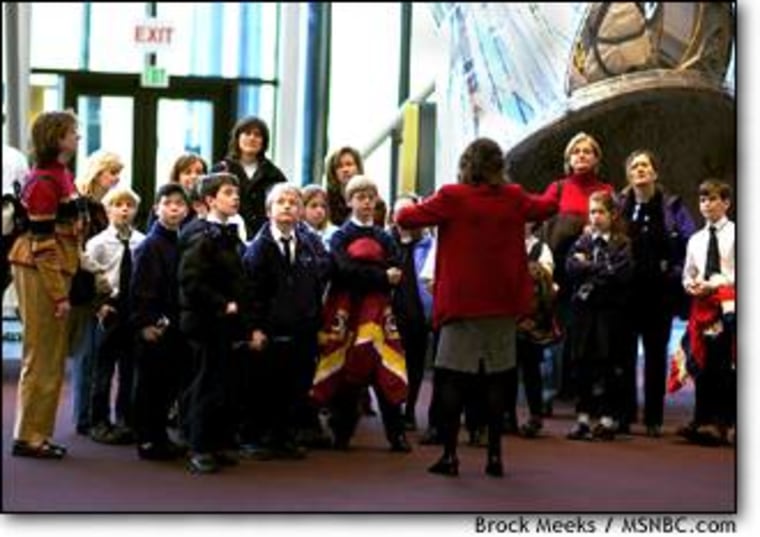The Columbia catastrophe has left NASA stunned, struggling to save the International Space Station and strapped with big concerns about its resources and its mission. But the tragedy also points out a bigger problem facing NASA: The romance of space flight may be fading, and along with it, America’s love affair with its astronauts and the agency that sends them aloft.
The students still pile into the National Air and Space Museum here and stare dreamy-eyed at the famous spacecraft wired to the exhibit hall’s ceiling. But the non-stop coverage of Columbia’s tragic end has darkened their dreams. Would they like to grow up to be astronauts?
“I think it’s too dangerous,” says Dominique, an elementary school student from Virginia. “You never know when you could die.”
Her friend Brad agrees:
“There are all of these buttons and triggers. It’s very dangerous.”
If young people no longer want to grow up to be astronauts, then NASA is in trouble, for the space agency has long seen the astronaut corps as its greatest weapon for winning public support — and congressional funding — for its programs.
“The astronauts have been a very useful group of individuals to help communicate to the public what it is that NASA is doing and why they are doing it,” says former NASA historian Dr. Roger Launius, now a curator at the Air and Space Museum.
A special kind of influence
The astronauts’ clout was never directly with Congress, although space travelers such as John Glenn could wow a congressional hearing. It is NASA’s vast engineering complexes in Texas, Florida and California, plus support from major defense contractors such as Boeing and Lockheed-Martin, that have given the space program its political muscle.
Rather, the astronauts’ appeal was with the public.
“They [were] kind of the gladiators of the modern age, the knights of the medieval era in terms of representing our culture in the context of the Cold War,” says Launius.
At first, NASA officials were stunned at the public response to the Mercury astronauts. But they moved quickly to capitalize on their new treasure. “NASA realized it had a gold mine, as far as them being representatives for the agency,” says Mark E. Byrnes, author of “Politics and Space: Image Making by NASA.”
Life magazine won the exclusive rights to tell the astronauts’ stories and the magazine’s Loudon Wainwright Jr. (father of the folk singer) ghost-wrote their autobiography, “We Seven,” which became a national best-seller.
Defying gravity
And they were heroes. As Walter Cronkite reminded millions of Americans, they could be blown to bits on liftoff, their blood could boil if their spacecraft lost pressure in space, or they could even drown after re-entry, since pre-shuttle spacecraft parachuted back to earth into the ocean.
But that image began to change with the advent of the shuttle, prosaically described by NASA as the Space Truck. While the shuttle has had spectacular successes, such as the repair of the Hubble Telescope, most missions have been ignored by the public. With the exception of Sally Ride, the first American woman into space, Americans now learned the names of the shuttle astronauts only when they died unexpectedly in catastrophic accidents.
While fictional space travelers on Star Trek “go boldly where none have gone before,” their real-life counterparts stayed close to home: It’s been 30 years since a human last ventured outside of the earth’s orbit.
Help wanted
So where does NASA get its new heroes? Some NASA supporters look to a manned mission to Mars as a way to restore the romance to the space program. They say NASA could start now by pitching the International Space Station as the first step in that mission.
“We haven’t lived long-term in space,” says Peggy Wilhide, formerly NASA’s Associate Administrator for Public Affairs. “That’s something the space station will do. ... If you’re going to Mars, you will be gone for nine months to a year.”
But others believe that for now, the Mars mission is beyond NASA’s capabilities. “That may be too hard,” says John Logsdon, director of George Washington University’s Space Policy Institute. “We don’t really know how to do that yet.”
Logsdon proposes building a better vehicle to get people up into earth orbit safely and affordably, giving more Americans a chance to become astronauts themselves. But work on possible shuttle successors as the X-33 and the Orbital Space Plane showed there were lots of major problems to be resolved. “If President Bush had said [at the Columbia memorial service] he was going to spend $15 billion to build a shuttle replacement, I’m not sure it could be done,” Logsdon says.
Some say NASA could do a better job promoting its unmanned missions, where the agency has had impressive successes with the Mars Rover and the stunning photographs sent back from flybys of Jupiter and Saturn. But aside from hardcore space fans, they’ve drawn a yawn from the general public. “You don’t get a parade for robots,” quips Logsdon.
Which leaves NASA still looking for a new role for its astronauts.
“I think there’s something I like to call the mystique of the blue coveralls that they normally wear in public appearances,” says former NASA historian Launius. “Most of the astronaut corps is pretty nameless. But that doesn’t even matter. They walk in wearing those coveralls and immediately a line forms to talk to them. There is this cachet, this mystique — these are the best and the brightest that our society has to offer.”
But to keep those lines forming, NASA may need to find something more challenging for the astronauts to do.
Steve Johnson is a reporter for MSNBC’s Special Reports unit.
